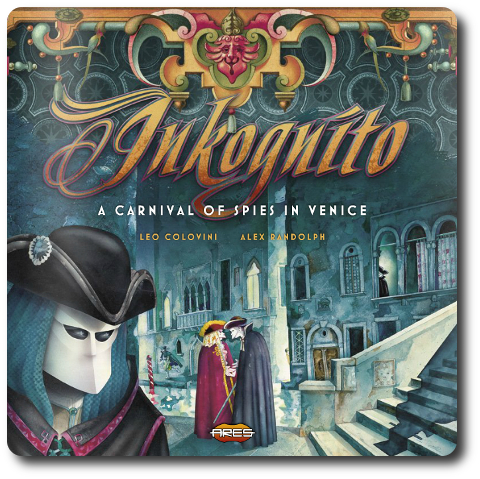
The Basics:
- For ages 7 and up (publisher suggests 13+)
- For 3 to 5 players
- Approximately 90 minutes to complete
Geek Skills:
- Active Listening & Communication
- Counting & Math
- Logical & Critical Decision Making
- Reading
- Memorization & Pattern/Color Matching
- Cooperative & Team Play
- Hand/Resource Management
- Bluffing and Misdirection
Learning Curve:
- Child – Moderate
- Adult – Easy
Theme & Narrative:
- Hide behind half-truths to find your secret objective
Endorsements:
- Gamer Geek mixed!
- Parent Geek approved!
- Child Geek approved!
Purchase:
Overview
It’s Carnival time in Venice. The sights and sounds of jubilation hide the many secret dealings among its fanfare and color. Wearing masks and cloaks to blend in with the party goers, suspicious characters move about making plans to sabotage and usurp. But the chaotic nature of the celebration makes it difficult to gleam the truth. If you are to be successful, you must learn what you can without giving yourself away in the process.
Inkognito, designed by Leo Colovini, Alex Randolph, and published by Ares Games, is comprised of 1 game board, 15 figures (in 4 different colors), 1 Ambassador figure, 1 Phantom of Prophecy, 4 Passports, 1 notepad, 32 cards (4 color sets of 8 cards each), and 12 Secret cards (3 sets of 4 cards each). The game component quality is excellent. The figures and Phantom of Prophecy are made of solid plastic (assembly required before playing the game), the cards are as thick as your standard playing cards, and the game board is made of thick cardboard. Big, too. It takes up a lot of table space, but then again, Venice isn’t exactly a small village. Not included with the game, but necessary to play, is a pen or pencil to write notes using the provided notepad.
Game Set Up
Note: Inkognito is normally played with 4 players. Game variants are provided for 3 and 5 player games. The game set up and summary of play described here is for the standard 4-player game. See “Game Variants” for a summary of 3 and 5-player game play.
To set up the game, first place the game board in the middle of the playing area. Place the Phantom of Prophecy in the upper left hand-corner of the game board or directly next to the game board. Place the Ambassador figure on the black circle with the Ambassador image. This is the Embassy.
Second, have each player choose a color and take the 4 figures, 4 Identity cards, 4 Build cards, and 1 Passport that match the player’s selected color. Any figures matching colored cards and Passports not selected are returned to the game box.

Example of the 4 figures a player will take as their own
Third, have each player take their 4 figures and place them on the 4 starting circles on the game board. This can be done simultaneously.
Fourth, give each player 1 note sheet from the notepad. Each player should now write down the names and colors of their opponents using the leftmost column and the first 3 rows. Do not use the 4th row, as this is reserved for information the player shares with their opponents.
Fifth, each player should now place their Passport in front of them and use it to shield the information they will record on their note sheet. The Passport lists the secret missions in the game and is useful as a quick reference during game play. As the game progresses, the players will be given secret missions to complete. The Passport will help guide the player without giving away the player’s intent to their opponents.
Sixth, take the 12 Secret cards and divide the deck into 3 groups to form 3 smaller decks: Identity, Build, and Mission. These cards look similar to the others already handed out, but are white and grey in color. The Identity deck is shuffled and 1 Identity card is dealt to each player, face-down. This card tells the player which agent persona they will be playing as. Then the Build deck is shuffled and 1 Build card is dealt to each player, face-down. This card identifies which of the 4 figures is the player’s true agent and which of the other 3 are friendly spies pretending to be agents. Finally, the Mission deck is shuffled and 1 card is dealt to each player, face-down. This is the player’s secret mission, It’s VERY IMPORTANT that none of the Secret cards are revealed to any opponents until shared during secret missions or the player wants another opponent to know exactly who they are. Players should keep the cards behind their Passports until they are needed, using their colored cards instead. Any Special cards not used should be returned to the game box without being shown to any of the players.

This player knows their half of the secret mission, their true identity and their build
That’s it for game set up. Determine who should go first and begin.
In the Shadows of Venice
Inkognito is played in turns with no set number of turns per game. A player’s turn is summarized here.
Step 1: Move
Movement in the game is guided by colored circles and line paths. Where a player can move on their turn is determined by the Phantom of Prophecy. Not visible in the Phantom of Prophecy plastic shell are a total of 10 small plastic balls of different colors (2 orange, 2 blue, 2 black, 3 white, and 1 purple).
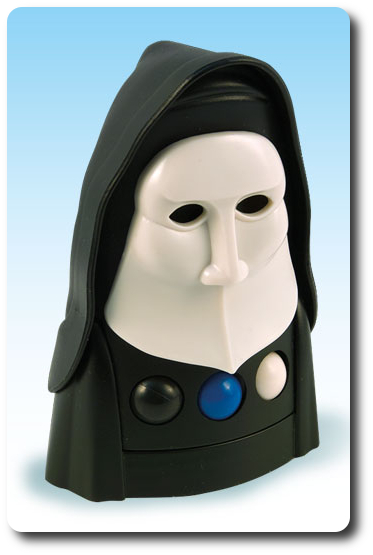
Each color indicates that a specific movement action can be taken. The possible colors and their meaning are as follows:
- Orange: 1 figure can be moved 1 circle using the orange line paths (orange represents ground movement)
- Blue: 1 figure can be moved 1 circle using the blue line paths (blue represents water movement)
- White: 1 figure can be moved 1 circle using the blue or orange line paths
- Purple: 1 opponent figure can be moved 1 circle using the blue or orange line paths
- Black: Ambassador figure can be moved 1 circle using the blue or orange line paths
All three colors indicated by the Phantom of Prophecy must be used on a players turn and can be used on one or split among any of their 4 figures. When moving, the player can end their movement on a circle with an opponent’s figure or the Ambassador. They can also move through any figure without stopping on the same circle if the Phantom of Prophecy allows it. However, a player is not allowed to stop their movement on a circle occupied by another of their figures. This includes stopping in a space with an opponent’s figure that is already occupied by another of the player’s figure, as well.
These same rules apply when moving an opponent’s figure with two exceptions. Players cannot move an opponent’s figure onto a circle occupied by another opponent, but ending movement on a circle occupied by the player’s figure is permissible. Players cannot move an opponent’s figure and end their movement on the same circle occupied by the Ambassador, either.
The Ambassador figure cannot be moved to a circle occupied by an opponent’s figure. All other movement is permissible.
After the player has moved using all three of the colors indicated by the Phantom of Prophecy, the player continues to the next step.
Step 2: Whispers in the Shadows
If a player’s figure occupies the same circle as an opponent’s figure or the Ambassador figure, they may ask them questions.
If the player is asking an opponent questions, they may ask for the following:
- “Please show me your identity.” If this question is asked, the opponent must hand over 2 Identity cards and 1 Build card. At least one of the cards given to the player MUST be true. The other 2 cards are false.
- “Please show me your build.” If this question is asked, the opponent must hand over 2 Build cards and 1 Identity card. At least one of the cards given to the player MUST be true. The other 2 cards are false.
It’s important to note that a player can, if they think it’s in their best interest, pass a Secret card. This should only be done, however, if the player is certain that the opponent asking them a question is their hidden partner. It’s risky, either way, as you are letting the other person know important information for free without knowing how they might use it.
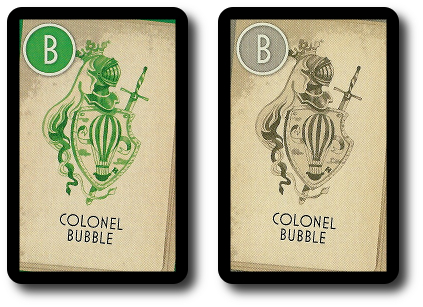
If you pass the green, you might be the Colonel. If pass the grey, you absolutely are.
When cards are given, make certain they remain hidden while being passed. Only the opponent handing the cards and the player receiving the cards should know what they are. When the cards are received, the player makes any notes on their note sheet they think necessary and hands the cards back.
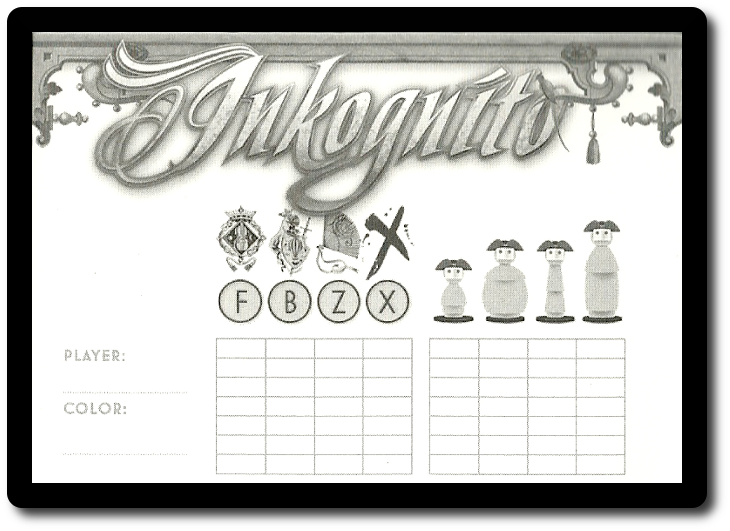
Everything a players knows (or thinks they know) should be recorded!
This is repeated once for every circle the player occupies with their figure and an opponent figure. However, each opponent can only be asked a question once, regardless if the player has more than one figure occupying the same space of the same colored opponent figures.
If the player is occupying the same circle as the Ambassador figure, they can ask any opponent to share with them 2 Identity cards or 2 Build cards. At least 1 of the cards given must be true.
Players should keep track of not only the cards they see, but those they share, as well. Players will be penalized if they are caught showing the same set of 3 cards to the same player more than once. The penalty for making this mistake is to show the opponent 1 less card, but at least 1 of the cards shown must be true. If caught showing the same cards again to the same opponent, only 1 card is shown that must be true. The penalty for showing the same cards to an opponent who is using the Ambassador is even stiffer. If the player is found to be sharing cards already shown, only 1 card is shown that must be true.
It’s important to note, however, that the opponent must identify the fault. If the player gets away with showing the same cards, it’s the opponent’s fault for not noticing.
Of course, the player can always argue that they are showing different cards. This is where the note sheet comes in handy. Players should record not only what cards they have been shown, but those they have shown to opponents, as well. If the player can validate (without cheating) that they are showing different cards, they are free and clear.
After questioning an opponent, the player relocates the questioned opponent’s figure to any unnumbered and unoccupied circle on the game board. If the Ambassador figure was questioned, the player places the Ambassador figure on the Embassy circle. If the Embassy is occupied, the player places the Ambassador figure on any unoccupied colored space.
Optionally, the player can elect to not ask questions and move their figure to another circle by land or by water using the line paths. All movement rules apply. Why not ask questions? Maybe the player has learned enough to win the game or doesn’t want to be asked a question by the opponent!
After the player has resolved each of their 4 figures, their turn is over. The next player in turn order sequence now goes.
Secret Missions and Hidden Agendas
As the game continues, players will begin to get a fuzzy picture of their opponents’ identities. Smart questions, good note taking, and logical thinking will sharpen this picture, bringing the facts into focus. Eventually, a player will have a strong indication that one of the opponents is their hidden partner. Each player Identity has a matching Identity they are attempting to find. They are as follows:
- Lord Fiddlebottom and Colonel Bubble are always partners
- Agent X and Madame Zsa Zsa are always partners
But finding them is only one part of the challenge. The next step is letting them know you are their hidden partner. This could be done through cards or through subtle hints. For example, winking or touching the tip of your nose. The objective is to inform and get a response that would suggest that the other player agrees and understands. Of course, the player could inadvertently be giving up a lot of information if they came to the wrong conclusion who their hidden partner is. This is where the notes kept in the game become very important. It’s also very important to not let other players know you have just figured out who you need to work with to win the game. Doing so immediately informs the other opponents that they are hidden partners.
After the player and the player’s hidden partner agree they are working together, the real Mission cards should be exchanged so both players know what needs to be done to win the game. The Passports are used to find what must be done to successfully win. After that, it’s just a matter of fulfilling the mission’s objective as quietly as possible.
Missions could require a specific figure of a specific build to be on a specific circle in order to meet the mission’s objective. The mission could also call for a named figure. The last challenge is to quickly work through the logistical problems of moving certain figures to certain locations using the Phantom of Prophecy and NOT letting the other player’s know what you are up to.
Not easy.
Winning the Game
The 2 players that complete their common mission win the game. A mission is considered “completed” when the conditions noted on the player’s Passport are met on either of the player’s turn who are attempting to complete the same mission.
Victory is announced by one player shaking the hand of an opponent who they believe to be their partner. If the handshake is returned, all the players review the supposed victory to ensure it’s legit. If the victory is announce prematurely, the handshake is not returned, or the team incorrectly guessed what the common mission was, the other 2 players win.
It’s possible that a player or players complete their common mission with their hidden partner unknowingly. These individuals do not claim victory since they did not knowingly pursue and complete their common mission. Better luck next time.
Game Variants
The two game variants for Inkognito cover slight changes in the rules of play for a 3-player game and a 5-player game. The standard game calls for 4 players, which evenly divides the table into 2 groups who must find their hidden partners. When there are an odd number of players, the game play adjusts itself to accommodate, providing a different gaming experience.
Three-Player Game
The 3-player game variant tasks the players to determine who their hidden partner is, just like the standard game, but one player’s partner (who represents the missing 4th player) has been imprisoned. The only way to win if your partner is in jail is to quickly leave the city. If you find that one of the opponents is your hidden partner, then your common mission must be completed as quickly as possible before the authorities arrest you, as well.
This game variant puts a little bit of heat into the game play. While the standard game does push the players to learn as much as they can as quickly as they can, the reduced number of players makes the process of deducing who is who somewhat easier. However, it also makes it easier to jump to conclusions. Players will have to ask themselves constantly if their hidden partner is still in the city or if they have been imprisoned.
Five-Player Game
The 5-player game allows a 5th player to play as the Ambassador figure. The Phantom of Prophecy is not used to determine movement for the Ambassador player. Instead, the Ambassador figure can be moved up to 2 circles using any line path. When the Ambassador player questions an opponent, they can ask for 2 Identify cards or 2 Build cards. One of the cards provided must be true. Then the Ambassador player sends the questioned opponent’s figure to any unnumbered and unoccupied circle on the game board.
The other players can question the Ambassador player as they normally would in a 3 or 4-player game and can move the Ambassador figure using the Phantom of Prophecy. When the Ambassador is questioned, any cards given are first handed to the Ambassador to review and then to the player who asked the question.
The players win as normal, attempting to find their hidden partner and completing their common mission. The Ambassador player wins the game if they learn the real Build and Identify of each of the players.
To learn more about Inkognito, visit the game’s web page.
Final Word
The Child Geeks were a bit slow to grasp the game. This was especially true with the younger and less experienced players. Those Child Geeks who had played Deduction games before quickly understood the game’s objective and got busy. The game play is easy, but it’s the learning curve of determining who opponents are that was found to be difficult. According to one Child Geek, “If I didn’t have the note sheet, I would have a hard time remembering what cards I saw, but I’m still having trouble taking notes.” Keeping an accurate record is very important in the game and some of the Child Geeks didn’t know how best to go about it. For the uninitiated, the note sheet was confusing to navigate. Another Child Geek said, “The best part of this game is getting enough information to know who people are. That’s a lot of fun, especially when they don’t know you know that you know.” All the games with the Child Geeks started on a high note, lost momentum during the middle of the game, and spiked again when players were racing to complete their missions. When all the games were over, the Child Geeks gave it some thought and decided that Inkognito was a game they enjoyed. Frustrating at times, for certain, but a game they liked. The Child Geeks approved Inkognito.
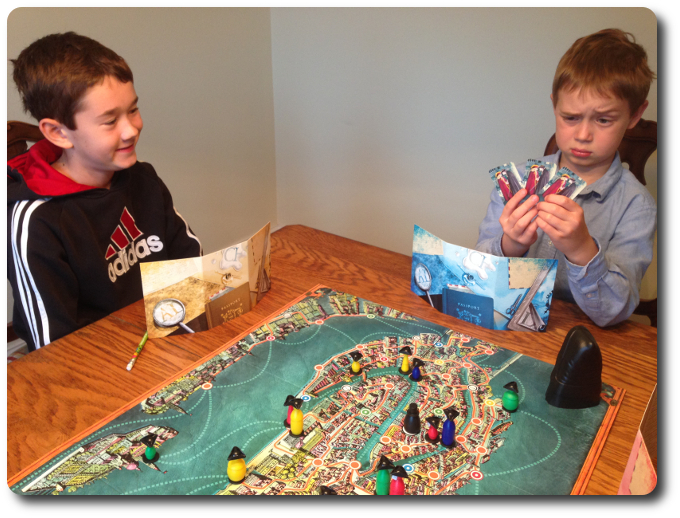
As one player tries to figure out what to do with the cards they were given, another looks on with a smirk
The Parent Geeks really enjoyed Inkognito, finding it to be a casual game that challenged them, but never overtaxed their mental energy. According to one Parent Geek, “This is a great game for me to play with friends, especially the ones with non-gamer spouses. The game is easy and what you have to do is easy to understand. Plus, it’s really interactive, keeping all the players engaged.” Some of the Parent Geeks questions all the movement in the game, finding it to be a bit distracting and unnecessary at times. As one Parent Geek put it, “I understand that the game is attempting to make us feel that we are moving in the shadows, but I am losing opportunities to learn information simply because the stupid Phantom didn’t give me the right colors. That doesn’t sit right with me.” Despite the Phantom not cooperating at times, the Parent Geeks enjoyed the game well enough to approve it.
The majority of Gamer Geeks were already familiar with Inkognito. It’s a game that has been around since 1988, after all. Being familiar with the game and Deduction games as a whole, Inkognito did nothing to surprise the gaming elitists. Those who had played the game before and liked it, still enjoyed it. According to one of these Gamer Geeks, “This game has always been one of my favorites. It’s a light and fun game of deduction. And it still is.” For those Gamer Geeks who didn’t like the game, they found no reason to change their mind after playing it again. According to one of these Gamer Geeks, “Random movement and repetitive game play make this game sluggish and uninteresting. There are better and faster games of deduction available making this one unnecessary.” All of the Gamer Geeks agreed that Inkognito was a game that would be fun for casual players, but had mixed feelings about it being a game for gaming elitists.
The Phantom of Prophecy is interesting. It acts like a themed dice tower, randomizing the movement actions the players can take. The spectacle of having a giant hooded and masked figure telling the player what they can and cannot do helps support the game’s narrative, but it’s also a bit harmful to the game play. Nowhere on the player’s Passports, cards, note sheet, or game board is there a key to be found that tells the players what the colors mean. This resulted in the game slowing down while players determined what actions they could take. As the game went on, the amount of time needed to look up the color meanings was reduced thanks to player memory. While not a significant dampener to the game play, the impact to the game’s pacing was noted by all our players.
Which brings us to the necessary movement in the game. This was mentioned by more than just a few of our Parent and Gamer Geeks who questioned its usefulness. The Child Geeks either didn’t mind or didn’t think to mention it, finding it to be a natural component to the game play. For everyone else, the movement across the board – and it’s a big game board – was sometimes painful and slow. But I was one of the few that thought it was an interesting idea. I rather liked that I could manipulate my opponent’s figures after questioning them. If I wanted to learn more from them, I moved their figures closer to me so we could exchange information again. If I didn’t think they were helpful, I pushed them as far away as possible. Ultimately, the distance that needs to be traveled isn’t great. It’s the random results that determine how you move that was problematic.
The game rules suggest you can “trick” opponents. I guess that would depend on your definition of “trick”. When players pass cards, one of the cards must represent something truthful, while the others are red herrings. When the player first gets cards from an opponent, there is no real way of knowing what is what. As the game continues, the player’s notes on their note sheet will help identify what cards are a distraction and what cards are worth while. Couple this with the fact that players must pass card sets to opponents that are always different, and an individual (who is paying attention) is always getting new information. But is any of this really tricking your opponent? I don’t believe so, as both parties involved already know that there is bad information involved. I would suggest this is “misleading”, not “tricking”. You are attempting to buy yourself time by clouding the facts. Tricking suggests you have a scheme that entails outwitting your opponent. You don’t have the time or the means to do this. At most, a player can outwit themselves by simply not paying attention.
Finally, this game is not for dim or easy distracted people. You have to pay attention. Not only to what cards you are getting, but to the faces of those who are passing the cards. You have to watch other players as they do the same. You have to constantly be observing, deducing, and recording. You can also bluff a whole lot, making it difficult for others to determine what the heck is going on. Again, I don’t think this is tricking people. This is good ol’ fashioned misleading, as you cannot outwardly lie, but you most certainly can tell half-truths.
Inkognito is an entertaining game. It sounds much more difficult than it actually is, but once you start playing it, it all makes sense and the real difficulty is keeping everything straight in your head. I’ve played many Deduction games, and while I don’t think Inkognito is doing anything spectacular, it entertained me. It can feel slow at times and you have my pity if you are playing with someone who is as dumb as a box of rocks, but not once did I feel bored. Less engaged, most certainly, but never bored. If you like sleuthing, logical deduction, and are looking for a visually appealing and casual playing game for your family gaming table, do give Inkognito a try. You might secretly learn it’s the game you’ve been looking for.
This game was given to Father Geek as a review copy. Father Geek was not paid, bribed, wined, dined, or threatened in vain hopes of influencing this review. Such is the statuesque and legendary integrity of Father Geek.



